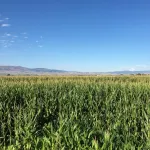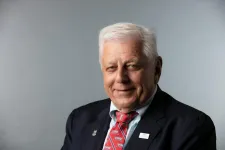(Press-News.org) One-third of the Earth's surface is covered by more than 11,000 grass species -- including crops like wheat, corn, rice and sugar cane that account for the bulk of the world's agricultural food production and important biofuels. But grass is so common that few people realize how diverse and important it really is.
Research published today in the journal Nature provides insights that scientists could use not only to improve crop design but also to more accurately model the effects of climate change. It also offers new clues that could help scientists use leaf fossils to better interpret the climate of the ancient past.
The study's senior author is Lawren Sack, a UCLA professor of ecology and evolutionary biology and one of the world's most influential scientific researchers.
The research determined that grass with narrow leaves and high numbers of veins should be better able to withstand the drier conditions expected in the future. That finding should enable scientists to better predict grass species' ability to tolerate cold and drought -- important for conserving species amidst climate change. It also suggests that scientists who are breeding agricultural grasses to better survive cold climates and drought should turn their focus toward varieties with smaller leaves and more large veins.
From other types of plants, scientists have learned that leaf size is an important factor in how plants adapt to their environments. But until now, it was not known how thousands of species of grass could exist in so many diverse environments, and whether leaf size might play a role.
"Grass leaf blades can vary in size from a few square millimeters for grasses of the high Andes to more than a square meter for tropical bamboos," Sack said.
Sack, UCLA doctoral student Alec Baird, and other scientists from the U.S. and the U.K. compiled a database of blade sizes, native climates and evolutionary relationships for grasses across the globe. They found that smaller grass blades dominate in arid and cold environments.
That's because over history, grass species spread out of the tropics and large-leafed species were filtered out of locations with hot, dry summers or cold winters, said Baird, the study's lead author.
Smaller leaves are beneficial for plants because they accumulate a thinner layer of still air coating their surface than larger leaves do. That helps them cool faster on hot days and avoid chilling on cold nights, Sack explained.
The study also revealed new insights about leaves' vein systems, and how the veins in small grass leaves specifically provide cold and drought tolerance.
Veins distribute the nutrients and water that leaves need to conduct photosynthesis -- the function by which plants convert sunlight and carbon dioxide into sugar. Studies of other types of plants showed that leaves create their first veins when they are newly formed, and those veins then get spaced farther apart as the leaves expand, Sack said. As a result, larger leaves have a smaller number of large veins in any given area, making them more vulnerable to stress than smaller leaves.
The reason that the number of veins matters is that, for any plant to grow, leaves use openings called stomatal pores on their surface to capture carbon dioxide. But opening those pores exposes the moist interior of the leaf, which causes plants to lose large amounts of water through evaporation. To replace that water, plants pull up water from the soil through their roots, stems and leaf veins within pipe-like structures called xylem.
But if the soil is too dry or cold, or if the xylem pipes freeze, air bubbles can form, blocking water from spreading throughout the plant. Research on non-grass plants has shown that's less of a problem in smaller leaves with greater number of veins packed closer together, because there are enough veins to route water around such blockages.
"But it wasn't clear why smaller-sized grasses would have any of these advantages that are known for leaves of other types of plants," Baird said. "Most grass blades are already, on average, hundreds of times smaller than typical flowering plant leaves, and they have parallel, rather than tree-like, vein systems."
The researchers made thousands of measurements of grass vein systems, and used computer models to examine the influence of the size of grass leaves and vein traits on how efficiently each species performed photosynthesis.
"We found that even though there are so many variations in the structure of grass blades, smaller grass blades across the board have dramatically more large veins packed together than larger grass blades, providing drought and freezing tolerance," Baird said. "Smaller grass leaves also tend to contain smaller pipes inside, which can better resist air blockage."
The research was funded by the National Science Foundation.
Sack said the mathematical equations the scientists devised as part of the study could also be used to estimate the size of intact blades of grass from fragmentary remains in fossil beds dating back tens of millions of years -- as well as to draw conclusions about the climates in which they grew.
"Everything we learn about grasses holds important value for our food and our ecosystems," he said. "Poet Walt Whitman pointed out the enormous knowledge that people can learn while contemplating leaves of grass, and I think he would be pleased that with these new findings, we are learning lessons from trillions of grass leaves worldwide."
INFORMATION:
Orthopaedic researchers are one step closer to preventing life-long arm and leg deformities from childhood fractures that do not heal properly.
A new study led by the University of South Australia and published in the journal Bone, sheds light on the role that a protein plays in this process.
Lead author Dr Michelle Su says that because children's bones are still growing, an injury to the growth plate can lead to a limb in a shortened position, compared to the unaffected side.
"Cartilage tissue near the ends of long bones is known as the growth plate that is responsible for bone growth in children and, unfortunately, 30 per cent of childhood and teen fractures involve this growth ...
Researchers have used the evidence of pumice from an underwater volcanic eruption to answer a long-standing mystery about a mass death of migrating seabirds.
New research into the mass death of millions of shearwater birds in 2013 suggests seabirds are eating non-food materials including floating pumice stones, because they are starving, potentially indicating broader health issues for the marine ecosystem.
The research which was led by CSIRO, Australia's national science agency, and QUT, was published in the journal Marine Ecology Progress Series, that examined a 2013 seabird "wreck" in which up to 3 million ...
A coordinated global effort to reduce the production of greenhouse gas emissions from industry and other sectors may not stop climate change, but Earth has a powerful ally that humans might partner with to achieve carbon neutrality: Mother Nature. An international team of researchers called for the use of natural climate solutions to help "cancel" produced emissions and remove existing emissions as part of a comprehensive plan to keep global warming below 1.5 degrees Celsius -- the point at which damage to human life and livelihoods could become catastrophic, according to the United Nations' Intergovernmental Panel on Climate Change.
The researchers published their invited views on March 24 in ...
Recently, the team led by Professor WU Changzheng from School of Chemistry and Materials Science from University of Science and Technology of China (USTC) in cooperation with the team led by Prof. WU Hengan from School of Engineering Science, realized the homogenization of surface active sites of heterogeneous catalyst by dissolving the electrocatalytic active metal in molten gallium. The related results have been published on the Nature Catalysis on March 11th.
Due to the existence of various defects and crystal faces, the active components on the surface of heterogeneous catalysts are often in different ...
Tsukuba, Japan - Physical exercise has long been prescribed as a way to improve the quality of sleep. But now, researchers from Japan have found that even when exercise causes objectively measured changes in sleep quality, these changes may not be subjectively perceptible.
In a study published this month in Scientific Reports, researchers from the University of Tsukuba have revealed that vigorous exercise was able to modulate various sleep parameters associated with improved sleep, without affecting subjective reports regarding sleep quality.
Exercise is ...
Lugano, Switzerland; Denver, CO, USA, 25 March 2021 - Clinical activity with a second drug inhibiting KRASG12C confirms its role as a therapeutic target in patients with advanced non-small-cell lung cancer (NSCLC) harbouring this mutation, according to results from a study with the KRASG12C inhibitor adagrasib reported at the European Lung Cancer Virtual Congress 2021. (1)
"As we strive to identify the oncogenic driver in more and more of our patients with NSCLC, it becomes critical that we develop therapies that can target these identified oncogenic drivers," said lead author Gregory Riely, from Memorial Sloan Kettering Cancer Center, New York, ...
For the first time, activation of nuclear receptor coactivator 3 (NCOA3) has been shown to promote the development of melanoma through regulation of ultraviolet radiation (UVR) sensitivity, cell cycle progression and circumvention of the DNA damage response. Results of a pre-clinical study led by Mohammed Kashani-Sabet, M.D., Medical Director of the Cancer Center at Sutter's California Pacific Medical Center (CPMC) in San Francisco, CA were published online today in Cancer Research, a journal of the American Association for Cancer Research.
"Our research suggests a previously unreported mechanism by which NCOA3 regulates the DNA damage response and acts as a potential therapeutic target in melanoma, whereby activation ...
Durham, NC - Depletion of a certain type of stem cell in the womb lining during pregnancy could be a significant factor behind miscarriage, according to a study released today in STEM CELLS. The study, by researchers at Warwick Medical School, University of Warwick, Coventry, England, reports on how recurrent pregnancy loss is a result of the loss of decidual precursor cells prior to conception.
"This raises the possibility that they can be harnessed to prevent pregnancy disorders," said corresponding author Jan J. Brosens, M.D., Ph.D., professor of obstetrics and gynecology at Warwick Medical School (WMS).
The womb lining - or endometrium - is a ...
Perhaps the best hope for slowing climate change - capturing and storing carbon dioxide emissions underground - has remained elusive due in part to uncertainty about its economic feasibility.
In an effort to provide clarity on this point, researchers at Stanford University and Carnegie Mellon University have estimated the energy demands involved with a critical stage of the process. (Watch video here: https://www.youtube.com/watch?v=-ZPIwwQs9aM)
Their findings, published April 8 in Environmental Science & Technology, suggest that managing and ...
Smoking cigarettes causes 480,000 premature deaths each year in the United States, due mainly to a two-fold risk of cardiovascular disease and a 20-fold risk of lung cancer. Although smoking rates have declined dramatically, there are currently 35 million smokers in the U.S.
In a commentary published in the Ochsner Medical Journal, Charles H. Hennekens, M.D., Dr.PH, senior author, the First Sir Richard Doll Professor, and senior academic advisor in the Schmidt College of Medicine at Florida Atlantic University, and colleagues, highlight how failure to institute smoking cessation in hospitalized patients is a missed opportunity to avoid many premature deaths.
Each year in the U.S., ...




